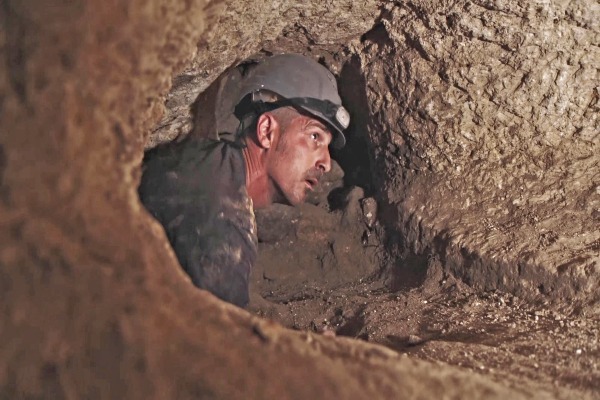The largest hiding elaborate found out in the Galilee, at Huqoq, 2024 (Image: Emil Aladjem/IAA).
Archaeologists uncovered an intensive hiding elaborate from the time of the Bar Kokhba Revolt (132 134 A.D.), marking a substantial obtain in the history of Jewish resistance versus Roman rule.
Positioned in close proximity to the Sea of Galilee in Huqoq (Israel), the complicated was disclosed by way of an in depth excavation effort led by the Israel Antiquities Authority (IAA), involving hundreds of contributors together with students, volunteers and soldiers.
https://www.youtube.com/check out?v=7A6fUKiy1LM
The excavation, which took position over many months, get rid of mild on the preparations produced by the inhabitants of Huqoq in advance of the two Jewish revolts towards the Romans in 66 A.D. and the Bar Kokhba Revolt in 132 A.D.
Citizens converted a water cistern, at first dug for the duration of the Second Temple period of time, into a hiding intricate. More tunnels and cavities were developed, permitting them to move beneath the houses, thus thwarting the pursuit by heavily armed Roman soldiers of Emperor Hadrians military.

Uri Berger at the hiding complex (Photograph: Emil Aladjem/IAA).
The Bar Kokhba Revolt is named following the Jewish ruler who led it versus the Romans, who was also witnessed as the Messiah by lots of Jews through the many years 132 135 A.D.
The Jews had been searching for to get rid of the Roman Empire’s domination and to rebuild the Jewish temple at Jerusalem, previously destroyed in 70 A.D. by Roman Emperor Titus. The revolt was a full disaster for the Jews and a significant victory for the a lot of Roman legions that came to Judea.
Amongst the discoveries in this underground labyrinth ended up eight concealed cavities linked by tunnels, strategically dug at 90-degree angles to impede the progress of pursuers. The excavation also yielded artifacts these types of as broken clay and glass dishes and a exceptional ring setting, while the important stone it after held was not observed. The ring most most likely belonged to a young female or a girl hiding in the underground shelters.

A ring identified in the Huqoq hiding complex (Image: Dafna Gazit/IAA).
Huqoq, a Jewish town relationship back to the Early Roman interval, has been getting substantially archaeological consideration for its abundant historical importance. Mentions in the Jerusalem and Babylonian Talmuds attest to the existence of distinguished Jewish figures in the region throughout the third and fourth centuries A.D.
Close by, a synagogue adorned with intricate mosaics from the Byzantine period has been subject matter to an exploration by a crew from North Carolina University considering that 2011. The lovely mosaics were uncovered to the public in preceding publications through the last many years.
The discovery of the hiding elaborate gives insights into a difficult interval for the Jewish populace in Huqoq and the Galilee region. Uri Berger of the IAA and Prof. Yinon Shivtiel of the Safed Tutorial University, who directed the excavation, notes that although the complicated speaks of adversity, it also tells a tale of resilience and eventual prosperity for the inhabitants who emerged from hiding to rebuild their local community.

Teenage boys and ladies work at the excavation (Picture: Emil Aladjem/IAA).
The conclusions also contribute to scholarly debates about the extent of the Bar Kokhba Revolt, with most of the scientists suggesting that this type of complicated could have been well prepared for use all through the revolt. Underground tunnels from this time period are located on a huge scale in the Galilee area and also in other parts in Israel, displaying the worth of this guerilla Jewish revolt against Rome that was well prepared a long time in advance.
Scholars these days know that when the to start with Jewish revolt of 66-74 A.D. erupted spontaneously, the a person in 132 135 A.D. was meticulously prepared a prolonged time in progress. Its success ended up a lot far more devastating than the very first revolt. Additional excavations are predicted and should deliver a lot more clarity on this issue.
Plans are underway to create the Huqoq web-site into a general public attraction, showcasing its archaeological importance. With aid from the Ministry of Heritage, KKL-JNF, and nearby authorities, attempts are becoming designed to be certain that this historic treasure becomes accessible to visitors from all-around the globe.
The Huqoq web-site represents a convergence of mother nature, tourism, and archaeology, providing a distinctive glimpse into the earlier even though promising exciting prospective customers for the foreseeable future of archaeological tourism in Israel and past.


![[VIDEO] Sim banu | Put In Us A Hunger [Hebrew Worship Session] » Kehila News Israel](https://insightkurdistan.com/wp-content/uploads/2024/03/VIDEO-Sim-banu-Put-In-Us-A-Hunger-Hebrew.jpeg)




